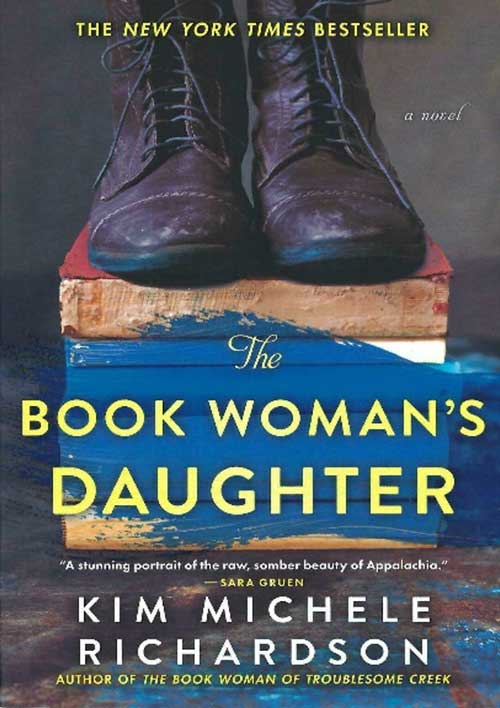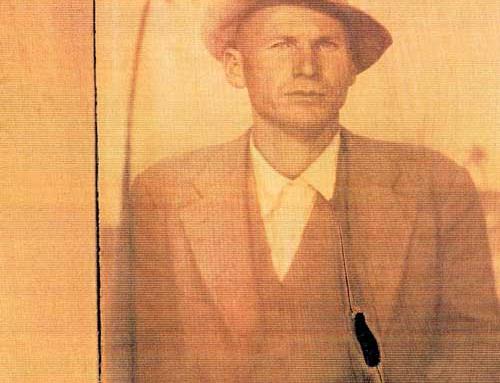For those who loved “The Book Woman of Troublesome Creek,” author Kim Michele Richardson offers another fine evocation of the often cruel conditions of rural Appalachia in the last century and a powerful portrait of the courageous women there who fought against ignorance, misogyny, and racial prejudice. Steeped in an intimate knowledge of the traditions and lore of the region and written with a loving eye to the natural beauty of the landscape, “The Book Woman’s Daughter” is a brilliant and compelling narrative sure to please readers already familiar with Richardson’s work and certain to capture a well-deserved host of additional fans. It is a beautiful, heartbreaking yet uplifting tale of the determined and resilient women of Appalachia.
 In the ruggedness of the beautiful Kentucky mountains, sixteen-year-old Honey Lovett has always known that the old ways can make a hard life harder. As the daughter of Cussy Mary Carter, the famed blue-skinned Troublesome Creek packhorse librarian, Honey and her family have been hiding from the law all her life. But when her mother and father are imprisoned for violating Kentucky’s miscegenation laws (her father married a “woman of color,” a blue-skinned woman) Blues were considered (by unenlightened and racist neighbors) to be “colored”. Thus they could not marry non-Blues under Kentucky’s miscegenation laws. Honey realizes she must fight to stay free or risk being sent away for good.
In the ruggedness of the beautiful Kentucky mountains, sixteen-year-old Honey Lovett has always known that the old ways can make a hard life harder. As the daughter of Cussy Mary Carter, the famed blue-skinned Troublesome Creek packhorse librarian, Honey and her family have been hiding from the law all her life. But when her mother and father are imprisoned for violating Kentucky’s miscegenation laws (her father married a “woman of color,” a blue-skinned woman) Blues were considered (by unenlightened and racist neighbors) to be “colored”. Thus they could not marry non-Blues under Kentucky’s miscegenation laws. Honey realizes she must fight to stay free or risk being sent away for good.
Honey eventually convinces lawyer Bob Morgan to represent her in a bid for legal emancipation, culminating in a climactic courtroom scene complete with damaging testimony from a racist social worker and a misogynist sheriff.
To avoid being sent to the House of Reform—essentially a prison for children, Honey picks up her mother’s old Pack Horse library route and she and her trusty mule Junia begin to deliver books to the remote hollers of Appalachia. Honey is looking to prove that she doesn’t need anyone telling her how to survive. But the route can be treacherous, and some folks aren’t as keen to let a woman pave her own way.
If Honey wants to bring the freedom books provide to the families who need it most, she’s going to have to fight for her place and, along the way, learn that the extraordinary women from the hills and hollers of eastern Kentucky can make all the difference in the world.
Packed with Appalachian history, “The Book Woman’s Daughter” examines women’s rights, extreme poverty, the treatment of minors in 1950s Kentucky, and the power of women helping women. The friendship between Honey and Pearl, the region’s first female firewatcher, is delightful and a glimpse of rural teenage life in the 1950s.
The characters might be inspirational, but this is not a shiny, sanitized version of history. This well-researched novel does not shy away from the harsh realities of life in a poor, rural community. Honey and her friends regularly face violence, on both a personal and institutional level.
The undeniable warmth that permeates Kim Michele Richardson’s fiction is rooted in a love for her home state of Kentucky, her characters and, it seems, the art of writing itself. Her narratives are immersive exercises in character development that are wholly capable of enveloping readers, pulling us deeper with each page until we are happily lost. I enthusiastically recommend both of Richardson’s books.
“The Book Woman’s Daughter” is available at the Jesse Stuart Foundation Bookstore at 4440 13th Street in Ashland. For more information call 606-326-1667 or email jsf@jsfbooks.com.
By James M. Gifford
JSF CEO & Senior Editor
For those who loved “The Book Woman of Troublesome Creek,” author Kim Michele Richardson offers another fine evocation of the often cruel conditions of rural Appalachia in the last century and a powerful portrait of the courageous women there who fought against ignorance, misogyny, and racial prejudice. Steeped in an intimate knowledge of the traditions and lore of the region and written with a loving eye to the natural beauty of the landscape, “The Book Woman’s Daughter” is a brilliant and compelling narrative sure to please readers already familiar with Richardson’s work and certain to capture a well-deserved host of additional fans. It is a beautiful, heartbreaking yet uplifting tale of the determined and resilient women of Appalachia.
In the ruggedness of the beautiful Kentucky mountains, sixteen-year-old Honey Lovett has always known that the old ways can make a hard life harder. As the daughter of Cussy Mary Carter, the famed blue-skinned Troublesome Creek packhorse librarian, Honey and her family have been hiding from the law all her life. But when her mother and father are imprisoned for violating Kentucky’s miscegenation laws (her father married a “woman of color,” a blue-skinned woman) Blues were considered (by unenlightened and racist neighbors) to be “colored”. Thus they could not marry non-Blues under Kentucky’s miscegenation laws. Honey realizes she must fight to stay free or risk being sent away for good.

Honey eventually convinces lawyer Bob Morgan to represent her in a bid for legal emancipation, culminating in a climactic courtroom scene complete with damaging testimony from a racist social worker and a misogynist sheriff.
To avoid being sent to the House of Reform—essentially a prison for children, Honey picks up her mother’s old Pack Horse library route and she and her trusty mule Junia begin to deliver books to the remote hollers of Appalachia. Honey is looking to prove that she doesn’t need anyone telling her how to survive. But the route can be treacherous, and some folks aren’t as keen to let a woman pave her own way.
If Honey wants to bring the freedom books provide to the families who need it most, she’s going to have to fight for her place and, along the way, learn that the extraordinary women from the hills and hollers of eastern Kentucky can make all the difference in the world.
Packed with Appalachian history, “The Book Woman’s Daughter” examines women’s rights, extreme poverty, the treatment of minors in 1950s Kentucky, and the power of women helping women. The friendship between Honey and Pearl, the region’s first female firewatcher, is delightful and a glimpse of rural teenage life in the 1950s.
The characters might be inspirational, but this is not a shiny, sanitized version of history. This well-researched novel does not shy away from the harsh realities of life in a poor, rural community. Honey and her friends regularly face violence, on both a personal and institutional level.
The undeniable warmth that permeates Kim Michele Richardson’s fiction is rooted in a love for her home state of Kentucky, her characters and, it seems, the art of writing itself. Her narratives are immersive exercises in character development that are wholly capable of enveloping readers, pulling us deeper with each page until we are happily lost. I enthusiastically recommend both of Richardson’s books.
“The Book Woman’s Daughter” is available at the Jesse Stuart Foundation Bookstore at 4440 13th Street in Ashland. For more information call 606-326-1667 or email jsf@jsfbooks.com.
By James M. Gifford
JSF CEO & Senior Editor



